Baek-kimchi literally translates as “white kimchi” in English, because it’s not made with Korean hot pepper flakes (gochugaru), which makes it whitish. It’s not spicy at all, but that doesn’t mean it’s bland! As you see in the video, it’s made with precious ingredients like chestnuts, jujubes, pine nuts, and a whole range of vegetables. It has a lot of fresh flavors, is incredibly refreshing, and is beautiful to look at!
This is a vegetarian recipe because unlike some other kimchi recipes I didn’t use fish sauce. But one variation would be to replace the 1 teaspoon of salt with 1 to 2 teaspoons of salted fermented shrimp.
It’s a great kimchi to make for special occasions.
“Oh, check this out, everybody! I made white kimchi!”
They will be impressed!
This is a good recipe for anyone who can’t take spicy food, and also for spicy food lovers who are looking for a change of pace. I usually love freshly made kimchi, but when it comes to baek-kimchi, I always wait until it ferments before I start eating it, which usually takes 1 to 3 days. It becomes a little fizzy, sweet, sour, and nutty – it’s a totally unique taste!
So many of my readers have requested this recipe over years. One of them, Kerry in Minnesota, requested it in 2009 and said:
“Despite being Korean, my stomach can’t handle spicy foods, but I would love to make kimchi. I don’t know if just cutting the amount of hot pepper flakes would make a much milder kimchi, but I would like to try making the white kind, which I hear isn’t spicy at all. Do you have any good white kimchi recipes, Maangchi-ssi?”
She added “ssi” at the end of my name to show me respect, Korean style!
Ok Kerry, here’s the recipe! Thanks for waiting!
Ingredients
- 1 large napa cabbage (3 pounds’ worth)
- ⅓ cup, 2 tablespoon plus 2 teaspoons kosher salt
- ½ pound Korean radish (or daikon) cut into matchsticks
- ¼ cup carrot, cut into matchsticks
- ¾ cup buchu (Asian chives), cut into 1 inch pieces
- 3 jujubes, seeded, cut into thin strips
- 2 fresh chestnuts, peeled and cut into thin strips
- 2 tablespoons pine nuts
- ½ of red bell pepper (⅓ cup’s worth), cored, seeded, and cut into thin strips
- 1 medium Korean pear (2 cups’s worth), peeled and cored
- 4 garlic cloves
- ½ cup onion
- 1 teaspoon ginger
Directions
Salt the cabbage:
- Cut the cabbage in half, then cut a slit through the core 2 inches above the stem, so the leaves are loosened but still attached.

- Rinse the halves under running water, or soak them in a basin for a few seconds until all the leaves are wet.
- Put the halves in a large basin and sprinkle ⅓ cup of kosher salt evenly between the leaves. Let them sit for 1½ to 2 hours, turning them over every 20 minutes.

- Rinse the cabbage under cold running water a couple of times to get rid of any dirt or salt. Split each half under the running water, to divide the cabbage into quarters. Cut out the remainder of the core. Drain and set aside.
Make the vegetable fillings:
- Combine radish, carrot, jujubes, chives, chestnuts, and red bell pepper in a bowl. Set aside.
Make seasoning mix for brine:
Make brine:
- Mix 4 cups of water and 2 tablespoons + 2 teaspoons of salt in a bowl with a wooden spoon. Stir it well until the salt is thoroughly dissolved.
- Put the blended seasoning mix into a cotton pouch, or wrap it a couple times in cheesecloth, and put it into the bowl of brine. Press it down with a spoon so the delicious blended flavors seep through. Squeeze it a bit and stir the brine for a while. Remove the pouch.

Make kimchi:
- Spread the vegetable fillings between each leaf of the cabbage. Fold the stuffed cabbage quarters over and put them into a container, glass jar, or Korean earthenware pot.

- Pour the brine over the kimchi so it’s submerged.


- Cover and let sit at room temperature until it starts fermenting, which should be between 1½ to 3 days depending on how warm your room is. A warmer room will ferment faster. Just keep an eye on the kimchi and taste it now and then: when the brine turns sour, it’s fermenting.
- Move it to the fridge, which will slow down the fermentation process. It will keep for about 1 month. Serve cold.
Maangchi's Amazon picks for this recipe
It's always best to buy Korean items at your local Korean grocery store, but I know that's not always possible so I chose these products on Amazon that are good quality. See more about how these items were chosen.



































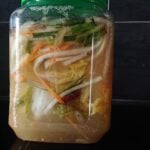

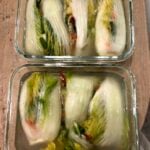
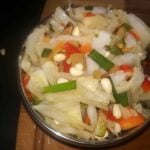
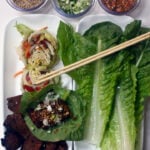
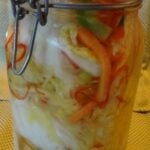
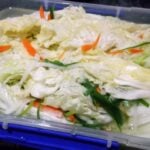
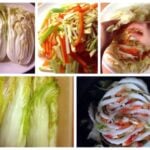
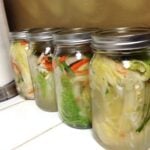
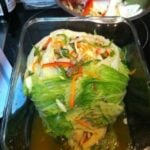
hi Maangchi-ssi
you said to put it 1 month in the fridge, can i also put it just 2 weeks in the fridge?
I meant this kimchi will be ok up to 1 month in the fridge. You still can eat it 1 month later but the flavor may change because there’s lots of brine in the kimchi. Yes, you can finish eating it in 2 weeks!
Good luck with your Korean cooking in 2023, too!
Love it. Are there any recipes you can use baek kimchi as an ingredient similar to using kimchi jjgae…or anything? Thanks!